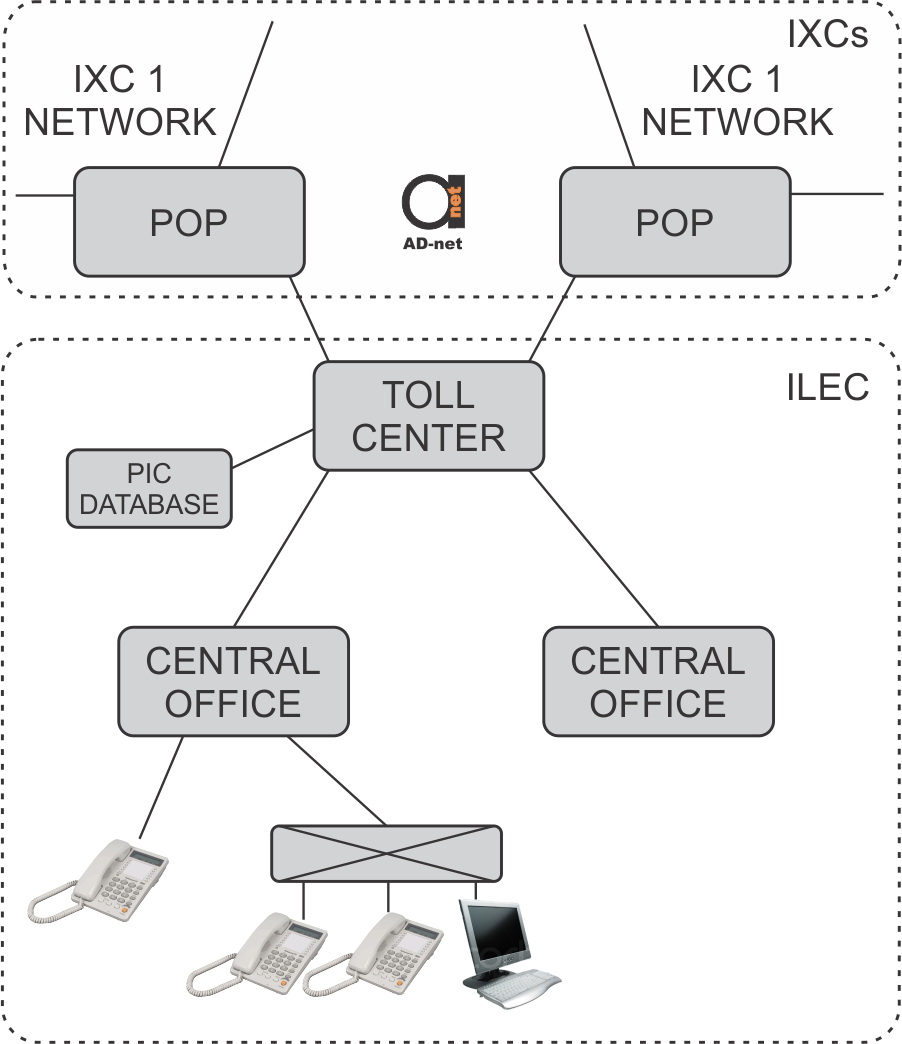In 1984, the Bell System in the USA was broken up in order to introduce competition for data services and long-distance phone calls. In this model, the long-distance networks and the access network were owned by different companies that needed to work together to establish end-to-end connections.
The access network is also known as the last mile, or if you’re in that part of the business, the first mile. It is the physical cabling from the customer premise to the CO, the cabling in the CO itself, the physical cabling to the toll center and the cabling in most of the toll center. A company that owns the access network is known as a Local Exchange Carrier (LEC).
With the advent of local competition, a new term was added – these companies are now known as the Incumbent Local Exchange Carrier (ILEC), meaning that they owned the access network first.
Long Distance: IXCs
Long-distance networks connect toll centers in different cities. Inter-Exchange Carriers (IXCs) own and operate these long lines. An IXC that mostly owns their own physical transmission facilities, typically equipment and fiber-optic cables, is referred to as a facilities-based IXC.

Figure 1: IXC’s, POP’s and ILEC
Facilities-based carriers lease capacity to resellers to form a network. Both of these companies are Inter-Exchange Carriers.
Many reseller-type IXCes were started once competition was introduced due to the pricing structure at the time. They would lease high-capacity services from IXCs, and sign up customers who route their calls over the high-capacity leased service, thus buying wholesale and selling retail.
When retail prices subsequent dropped, resellers’ profit margins were reduced drastically, resulting in many going out of business, or pivoting into operations that are more facilities-based.
Switched Access
IXCs have equal access to ILEC’s last mile. Put differently, ILECs are required to provide their customers equal access to competitive IXCs.
ILEC customers can select any IXC, and the ILEC will connect the customer to the IXC in the toll center on a call-by-call basis. This is known as switched access. The ILEC at each end bills the IXC on a per-minute switched access basis for the connection to the last mile.
Point of Presence (POP)
The termination of the IXC’s cabling in the toll center was previously known as a Point of Presence (POP). This term was coined when different agreements, regulations and court decisions forced the Bell System to provide physical space in toll centers where competitors like MCI could house equipment and terminate fibers.
This room was MCI’s presence in the toll center and it was referred to as “the MCI equipment room”. From the IXC’s point of view, it is the end of their physical circuits while it is the beginning of the IXC’s network from the ILEC’s point of view.
The term POP is now used more generally, meaning a building where a competitive carrier terminates at least two fiber-optic cables to provide a station on a regional ring. Nowadays, this building is often not actually the toll center, but a different building across town or across the street connected to the toll center with fiber.
PIC Codes and Equal Access
Equal access means that customers can select the IXC that will handle its long distance call in advance, and the routing through the POP on to the IXC’s network and the toll center is transparent to customers.
This is achieved with an entry in a database called the customer’s Preferred Inter-Exchange Carrier (PIC) code. The database is maintained by the ILEC. Each IXC has a Carrier Identification Code. AT&T’s carrier code is 0288 (ATP on a telephone keypad), MCI’s is 0222, Sprint’s is 0333 and Global Crossing’s is 0444.
There are obviously many others.
When an ILEC customer changes companies used for making long distance calls, the customer’s PIC code is changed to the carrier code of the new IXC. When making a call from a phone other than your own, such as a payphone, dialing 101, followed by the carrier code routes the call through a particular IXC manually.
Dialing 1010288 will for example connect to the POP belonging to AT&T, 1010222 will connect to MCI, 1010333 to Sprint and so on. Most of these companies also have a 1-800 number that achieves the same thing.
ILECs and IXCs were strictly separate companies in the USA in 1984. Due to changes in laws and regulations, the holding company that owns the ILEC today typically also owns one of the IXCs.
In Canada, the phone companies were not split into separate long-distance and local companies, but equal access to competitive IXCs was ordered in 1992.


